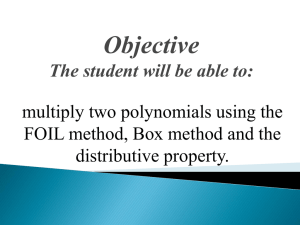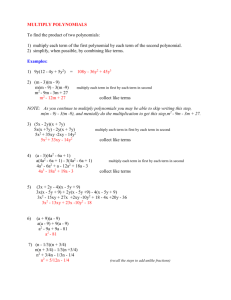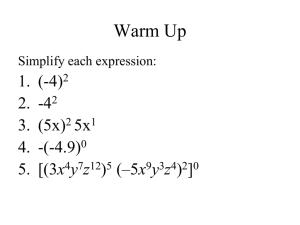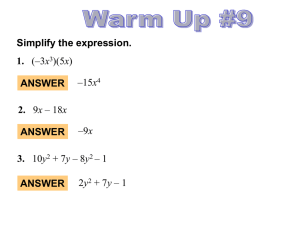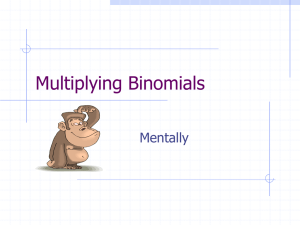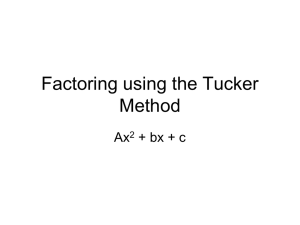(y + 7).
advertisement
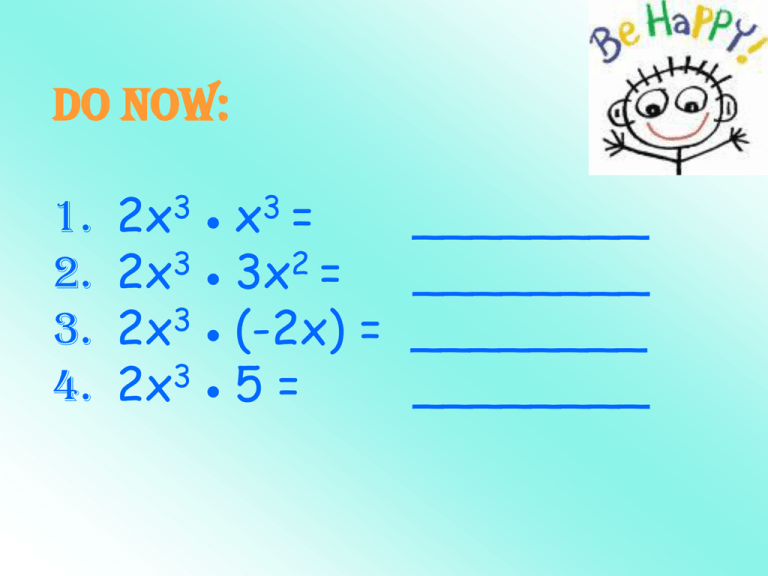
Do Now: 1. 2. 3. 4. 2x3 x3 = ________ 2x3 3x2 = ________ 2x3 (-2x) = ________ 3 2x 5 = ________ sO… 3 3 2 2x (x + 3x - 2x + 5) = The FOIL method is ONLY used when you multiply 2 binomials. It is an acronym and tells you which terms to multiply. Use the FOIL method to multiply the following binomials: (y + 3)(y + 7). (y + 3)(y + 7). F tells you to multiply the FIRST terms of each binomial. y2 (y + 3)(y + 7). O tells you to multiply the OUTER terms of each binomial. y2 + 7y (y + 3)(y + 7). I tells you to multiply the INNER terms of each binomial. y2 + 7y + 3y (y + 3)(y + 7). L tells you to multiply the LAST terms of each binomial. y2 + 7y + 3y + 21 Combine like terms. y2 + 10y + 21 Remember, FOIL reminds you to multiply the: First terms Outer terms Inner terms Last terms The 2nd method is the Box Method. This method works for every problem! Here’s how you do it: (3x – 5)(5x + 2) 3x Draw a box. Write a polynomial on the top & side of a box. It does not matter where. 5x This will be modeled in the next problem along with FOIL. +2 -5 3) Multiply (3x - 5)(5x + 2) First terms: 15x2 Outer terms: +6x Inner terms: -25x Last terms: -10 Combine like terms. 15x2 - 19x – 10 3x -5 5x 15x2 -25x +2 +6x -10 You have 2 techniques. Pick the one you like the best! 4) Multiply (7p - 2)(3p - 4) First terms: 21p2 Outer terms: -28p Inner terms: -6p Last terms: +8 Combine like terms. 21p2 – 34p + 8 7p -2 3p 21p2 -6p -4 -28p +8 Multiply (y + 4)(y – 3) 1. 2. 3. 4. 5. 6. 7. 8. y2 + y – 12 y2 – y – 12 y2 + 7y – 12 y2 – 7y – 12 y2 + y + 12 y2 – y + 12 y2 + 7y + 12 y2 – 7y + 12 Multiply (2a – 3b)(2a + 4b) 1. 2. 3. 4. 5. 4a2 + 14ab – 12b2 4a2 – 14ab – 12b2 4a2 + 8ab – 6ba – 12b2 4a2 + 2ab – 12b2 4a2 – 2ab – 12b2 So, what if you have a binomial x trinomial? Please copy: (x + 3)(x² + 2x + 4) Horizontal Method: (x + 3)(x² + 2x + 4) = x³ + 2x² + 4x + 3x² + 6x + 12 Write terms in descending order… = x³ + 2x² + 3x² + 4x + 6x + 12 Combine like terms = x³ + 5x² + 10x + 12 Vertical Method: x² + 2x + 4 x + 3 x³ + 2x² + 4x 3x² + 6x + 12 x³ + 5x² + 10x + 12 OK, your turn… 1. (x+1)(x²+2x+1) 2. (b2 + 6b –7)(3b – 4) 3. (2x2 + 5x –1)(4x – 3) 4. (2y – 3)(3y2 – y + 5) 5. (x2 + 2x + 1)(x + 2)
